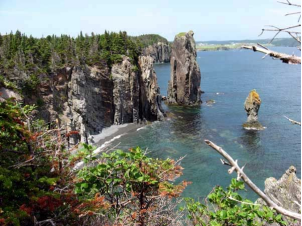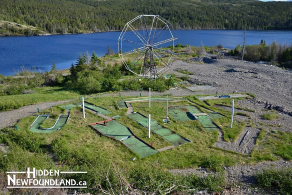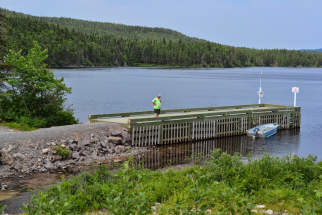Trinity, Newfoundland 作者: 来源: 发布时间:2021-12-03
I.Population and Area
-Area
Land: 12.92 km2 (4.99 sq mi)
-Population (2016)
Total: 169
Density: 13.1/km2 (34/sq mi)

II.Natural Geography (environment and resources)

-Trinity is a small town located on Trinity Bay in Newfoundland and Labrador. The town contains a number of buildings recognized as Registered Heritage Structures by the province.
III.ECONOMY
-Average Salary for State: Newfoundland and Labrador: C$57k

-Website: https://www.payscale.com/research/CA/State=Newfoundland_and_Labrador/Salary
IV.Industrial Characteristics
-Today, the efforts to preserve the history, architecture and natural landscape of Trinity have paid off. The Town is now a primary destination area for visitors to the province. As a result, businesses catering to the tourism industry - accommodations, food services, craft shops, art galleries and theater and tour companies - have opened. The successful Rising Tide Theatre Company has contributed to a revitalized local economy, an extended tourism season, and interest in heritage property investment. Investment in heritage preservation also supports contracting companies who have developed specific expertise in heritage renovations and products. Increased tourism marketing efforts and a generally improved provincial economy have also contributed to the success of the tourism industry at Trinity with increased numbers of visitors each year. The success at Trinity has also spilled over into other areas of the Bonavista Peninsula leading to creative regional tourism partnerships, packages and promotion.
-Providing opportunities for business investment will create jobs and help retain and attract young people to our Town. Ensuring that land is available for commerce and industry is key to the Town’s long term sustainability.
-The Town may require agreements for new developments involving residential, commercial, industrial or resource developments, and for the subdivision of land. Such an agreement will be negotiated between the developer and the Town, and include conditions for development and for financing of any services provided to the site which shall be constructed to municipal standards and consistent with the policies of this Plan and the Development Regulations.
-Website: http://www.townoftrinity.com/Town%20of%20Trinity%20Municipal%20Plan%20-%2015.pdf
V.Attractions
1. Skerwink Trail

-A 3.5 km trail along the coastline that runs parallel to the main road from the Town of Bonavista to the Cape. This trail provides one with a spectacular view of Bonavista Bay as you enjoy a leisurely walk on a marked trail to the Cape Bonavista Lighthouse. Along this route you can enjoy the rugged coast line while watching for birds and whales (in season). Stop for a picnic along the trail or at the John Cabot Municipal Park.
-Part of the Hike Discovery network this moderate to difficult 5.3-km loop coastal trail features sea stacks, whales, icebergs and eagles as well as views of the communities of Port Rexton and Trinity. This trail has been selected by Travel and Leisure Magazine as one of the top 35 walks in North America and Europe in its August 2003 World Best Awards issue.
-TEL: +1 (709) 464 3599
-Email: programming@hikediscovery.com
-Website: http://www.hikediscovery.com/cape.html
2.The Trinity Train Loop

-For 90 years the Newfoundland Railway was a vital way of transporting people and services across the island. The main railway line from St. Johns to Port Aux Basque was later joined by several smaller "branches" that connected many populated areas along the coast. In November of 1911 the owners of the Newfoundland railway, the Reid Newfoundland Company opened a line on the Bonavista Peninsula. For the most part, the railway line was fairly easy to design because of the low elevation changes found on most of the peninsula's interior.
-One problem arose however when they attempted to bring the train into the town of Trinity. The town is located along the coast and is surrounded by steep hills which would have made it impossible to get to by train. The solution was a two kilometer extension that would loop around a nearby pond (later named "Loop Pond") and gradually lower the railway tracks to an acceptable elevation. To do this the Reid Company hired the engineer J.P. Powell to design what would become known as The Trinity Loop.
-The Loop
-Powell designed a system where the incoming tracks in the northwest would cross over a valley, circle around the outside of a pond and then pass under itself while leaving the valley. The circumference of the loop was a little more than 2000 meters, the total elevation drop was around 10.3 meters and it rotated the tracks a total of 310 degrees. The loop was very unique and unusual feature to Newfoundland but was similar to features commonly seen in the mountain passes in western Canada.
-After Closing
-But shortly after hearing the news former railwayman, Clayton Cook began organizing campaigns and petitions to preserve the loop. With the help of several politicians, Terra Transport eventually transferred the loop over to the town of Trinity. It was too long after this that Francis Kelly purchased the land and turned the area into an amusement park which included boat rides, accommodations, amusement rides, a museum, and even a train ride around the loop. In February 1988, the Trinity Loop was registered as a heritage structure helping to preserve its history and structure from drastic change.
-Between 1910 and 1911 the loop was constructed and was used up until the Terra Transport Company closed the Bonavista branch line in 1984. The companies plan was to dismantle the loop and sell it for scrap.
-The park operated successfully for a number of years but as time went on, peoples interest in the park slowly declined and in 2004 the park was shut down. But even today there are still many people who want the loop to remain preserved and there are many who wish to see it saved from destruction.
-Today
-In September 2010 Hurricane Igor blew through the province earning it the title as the most destructive tropical cyclone to the hit the island. The storm was devastating for the Trinity Loop. Extensive rainfall caused the river flowing through the park to wash away nearly 100 feet of tracks and deposit rocks and sediment over any remaining features of the amusement park.
-Not everyone has given up on the park. After the previous owner defaulted on payments shortly after the park's closure the land was transferred over to the provincial government and has since been considered crown land. Several people over the years have attempted at reopening the park but none have been successful. Although there is a huge number of people on the island who would love to see the train carrying people around the pond again and the amusement park running, there are some who believe the loop has seen its last day.
-Website: https://www.hiddennewfoundland.ca/trinity-train-loop
3.Lockston Path Provincial Park

-Comprising 733 hectares, this park with its sheltered campsites and freshwater beach provides a good base camp for visits to the nearby historic communities.
-TEL: +1 (709) 637 2040
-+1 (877) 214 2267 (toll free)
-Email: nlcamping@gov.nl.ca
-Website: https://www.nlcamping.ca/
VI.History
-The harbour at Trinity was first used by fishing ships around the 16th century. The Portuguese explorer Gaspar Corte-Real named the location "Trinity" as he arrived on Trinity Sunday, 1501 although another account gives his arrival as 1500.
-Fishermen from the West Country of England began using Trinity as a summer station in the migratory fishery in the 1570s. Summer fishermen continued to be primarily from the Channel Islands, especially Jersey, and Weymouth in Dorset until a permanent settlement was established. Trinity was settled by merchants from Poole, England during the 18th century, citing reasons such as the easily defensible harbor and abundance of shore space for fishing premises. Trinity was the site that Sir Richard Whitbourne held the first court of Admiralty in 1615, establishing the first court of justice in North America.
-The merchant trade in Trinity was significant and dominated the social and economic life from Baie Verte to White Bay (Newfoundland and Labrador). At times, merchants in Trinity exported upwards of 30-40% of cod, train oil, and seals produced in Newfoundland. By the late 18th Century, the merchant firms in Trinity were operatoring 35 ocean-going ships, exporting 100,000 quintals of dried cod and supplying about 6,000 inhabitants.
-A fort was established at Admiral's Point near Trinity in order to protect the assets of the merchants. Due to Trinity's prominence in the British-Newfoundland trade, it was attacked and twice captured by the French in the Anglo-French Wars of 1696-1713, first in 1696 and again in 1705. Both times, the properties of the residents were burnt. Trinity was again captured by the French during the Seven Years' War by Admiral de Ternay.
-Trinity was the site of medical research, including the introduction of the smallpox vaccine to the new world in 1798 by John Clinch, a boyhood friend and medical colleague of Edward Jenner.
-Religious activities in Trinity date back to the early years. The first parochial church was built in 1729 and Rev. Robert Kilpatrick, the first missionary of the Society for Propagation of the Gospel, arrived. During a tumultuous time in Trinity's history, a visiting Methodist preacher, John Hoskins, was tarred by sailors in 1780 - a resident Methodist preacher did not arrive until 1816. Construction on a new parish church began in 1820 and housed the Rev. Aubrey Spencer who later became the first Church of England bishop of the diocese of Newfoundland and Bermuda. In 1827, St. Paul's Church in Trinity was consecrated by Bishop Inglis of Nova Scotia. For this occasion, the hymn "We Love the Place, O Lord" was composed by Rev. William Bullock and has since gained widespread use.
-The decline of Trinity began in the mid-19th century as major firms reduced their direct overseas trade and began to rely on commercial links with St. John's. The Ryan brothers of King's Cove and Bonavista continued their retail and general supply trade on the Lester-Garland Plantation until 1947.
-The Trinity Record, a weekly newspaper, was in print in Trinity from 1886 to 1900.
-Trinity was incorporated as a town in 1969.
-According to the 2016 Statistics Canada Census, the population of Trinity increased 23.4% from 2011 to 2016 and had 132 dwellings.
VII.Other information
-Infrastructure
-Policy RU-1 Rural uses Within the Rural land use designation, rural resource uses such as agriculture, forestry, conservation and recreation uses such as parks and trails will be permitted. Recreational uses associated with the tourism industry such as Tourism trailer parks may also be considered. Other uses, such as cemeteries, outdoor assembly uses, outdoor markets, general industry, light industry, telecommunications and antennae, aggregate resource extraction, mineral exploration, and in coastal areas, marine industrial uses such as wharves, fish processing plants, infrastructure associated with aquaculture operations, and marine services, may also be considered.
-Policy RU-2 Development potential in the Trinity Loop area It shall be the policy of Council to encourage redevelopment of the Trinity Loop Property for re-use as a commercial tourism attraction, or as a private residential development that could include a mix of residential and commercial uses. Proposals for redevelopment will be required to integrate, retain and preserve the Trinity Loop historic structure into the site development plan, provide for public park areas and ensure public access to the Trinity Loop, from within the development and the continuation of the railway right of way off the site. Development will also be required to provide an adequate water system capable of providing a sustainable supply of potable water for proposed uses, as well as an appropriate wastewater management system designed so as not to result in future demands on the municipality for piped servicing to the site.
-In considering development proposals for the site, Council shall also consider necessary upgrading of the public road to the site and may require as part of the conditions of approval, that the street be upgraded at the developer’s expense, to acceptable standards.
-Policy RU-3 Pits and quarries Mineral exploration and aggregate extraction activities will be required to obtain a permit or licence from the Mineral Lands Division of the Department of Natural Resources and comply with all conditions for development, operation, decommissioning and rehabilitation. Extractive resource activities and land uses in this designation shall be screened from public roads, residential areas, parks, trails, and if appropriate, from other rural uses, where possible, by leaving existing tree cover in place.
-Policy RU-4 Agriculture Agricultural uses are encouraged in the Rural land use designation. Livestock wastes and land management shall be carried out in accordance with agricultural best practices so as not to cause any nuisance or environmental impacts to adjoining properties. Intensive livestock operations will be subject to a development agreement with the Town.
-Website: http://www.townoftrinity.com/Town%20of%20Trinity%20Municipal%20Plan%20-%2015.pdf
VIII.Contact information
-Government
Mayor: Jim Miller
-Town of Trinity
21 West St.
P.O. Box 42
Trinity, NL A0C 2S0
-Phone/Fax:
(709) 464-3836
-Email: CouncilTrinity@netscape.net
-Website: http://www.townoftrinity.com/contact.asp
